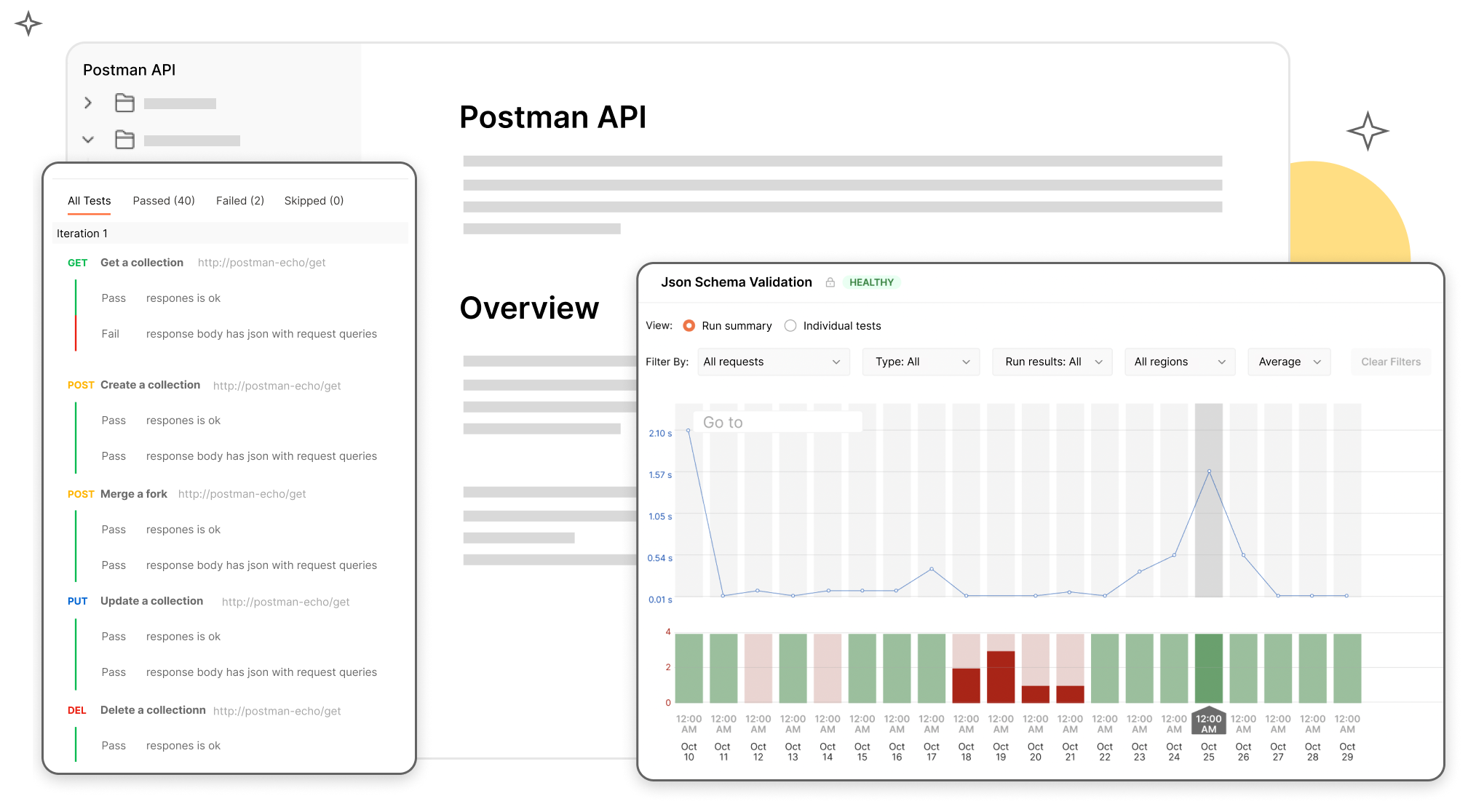API monitoring
Learn what API monitoring is and how it helps teams surface API-related issues—such as errors, latency, and security vulnerabilities—before they escalate.
What is API monitoring?
API monitoring is the process of gathering, visualizing, and alerting on API telemetry data to ensure that API requests are handled as expected.
APIs are crucial infrastructure components of modern applications; they connect internal microservices, power essential user journeys, and expose data and functionality to third-party consumers. API monitoring therefore plays an important role in helping teams surface API-related issues—such as errors, latency, and security vulnerabilities—before they escalate and negatively impact dependent services, partners, and customers. Whereas API testing is intended to support rapid iteration in the development stage, the primary goal of API monitoring is to reduce the mean time to resolution (MTTR) for consumer-facing problems in production.
Here, we'll discuss the role that API monitoring plays in an API-first world, the most common use cases for API monitoring, key API performance metrics to watch, and how Postman can help you implement a comprehensive API monitoring strategy.
Why is API monitoring crucial in an API-first world?
In recent years, many organizations have broken down their monolithic applications into independently-managed microservices, which typically run on cloud-based infrastructure and communicate with one another through internal APIs. Microservice-based applications tend to be more scalable and cost-efficient than their monolithic counterparts, but their dependency relationships also introduce a significant amount of complexity. For instance, a seemingly small change to one microservice's API can have unexpected consequences on the microservices it supports.
In addition to using APIs to connect internal microservices, some organizations have started to offer their APIs as billable products to third-party consumers. In this model, which is known as “API-as-a-Product,” API producers are responsible for upholding Service Level Agreements (SLAs) for availability, performance, and security, and an issue can erode customer confidence and lead to churn.
These industry-wide shifts have occurred alongside the rise in popularity of the API-first development model, in which teams develop APIs before developing the applications and integrations that depend on them. This strategy emerged in response to concerns about poorly designed and executed APIs, which are often not able to meet the demands of the services they support. API monitoring offers a systematized approach to maintaining API quality, making it a critical pillar of the API-first approach. The resulting APIs are resilient, easy to use, and well-equipped to handle the inherent challenges of microservice-based architectures and the API-as-a-Product model.
What are the primary use cases for API monitoring?
Every organization is different and will need to implement an API monitoring strategy that meets its specific needs. Nevertheless, there are several use cases for API monitoring that are broadly relevant to any team:
Confirming that individual requests remain healthy over time
The primary use case for API monitoring is to confirm that requests to an API continue to perform as expected over time. This is particularly important for agile development teams, which may deploy code changes several times a day. API monitoring can help these teams surface errors and performance degradations as soon as they occur, so they can deploy a fix before the issue impacts their consumers and customers.
Validating multi-step user journeys
Some of the most business-critical workflows chain requests together, and they sometimes involve multiple APIs. An effective API monitoring strategy therefore enables teams to systematically trigger these complex workflows and monitor the results at every step of the way.
Staying aware of issues in third-party APIs
If a team is unable to identify the source of an issue, a third-party API may be to blame. These teams can configure monitors for the third-party endpoints that they consume, which will keep them from troubleshooting problems that are out of their control.
Surfacing security vulnerabilities
An insecure API can provide an entry point for attackers, so it's important for teams to continuously monitor their APIs for vulnerabilities. This process involves configuring and running security checks in development, CI/CD pipelines, and production.
What are the key metrics for monitoring APIs?
APIs emit a range of signals that can provide important insight into their health and performance. It's important, however, to choose a monitoring tool that not only offers a high-level overview of this performance data, but also enables you to filter by key facets—such as request name, region, and environment—to understand an issue's scope. The most important metrics to monitor are:
What are some API monitoring best practices?
An API monitoring strategy will be most successful if it is customized to meet the unique needs of the business it supports. Nevertheless, the following best practices will promote consistently available, highly performant APIs at any organization:

Why use Postman for API monitoring?
When implementing an API monitoring strategy, it's important to choose a tool that is intuitive, comprehensive, and easy to integrate into your team's existing workflows. With the Postman API Platform, you can:
Learn more with Postman Academy's Collection-based API monitoring modules